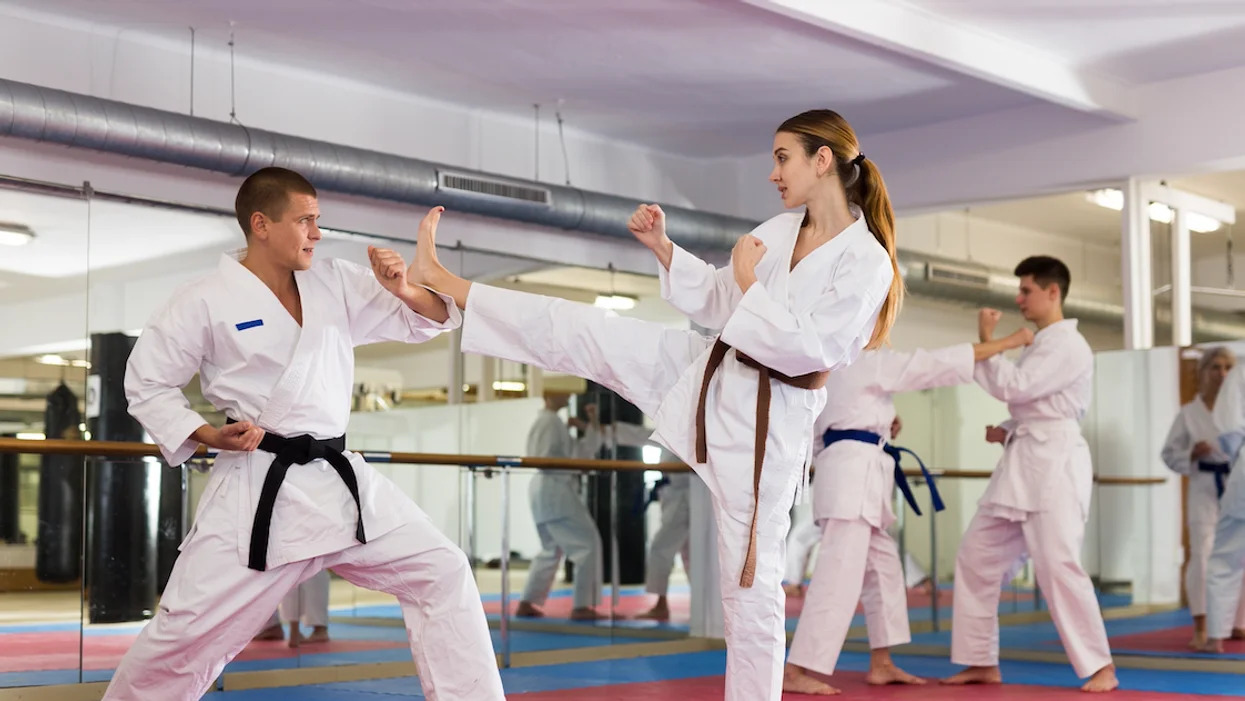Taekwondo Training: Get in Shape and Learn Self-Defense

In today’s fast-paced world, where safety and fitness are paramount, the ancient martial art of Taekwondo offers a unique blend of physical conditioning and self-defense skills. Whether you’re looking to improve your fitness, boost your self-confidence, or acquire practical self-defense techniques, Taekwondo is an excellent choice. In this comprehensive guide, we’ll explore the world of Taekwondo training, its benefits, and how you can embark on this rewarding journey.
Introduction to Taekwondo
Taekwondo, often referred to as the “art of kicking and punching,” originated in Korea and has evolved into one of the world’s most popular martial arts. Known for its high-energy kicks and dynamic movements, Taekwondo is not just a sport but a way of life for many practitioners.
A Brief History of Taekwondo
The history of Taekwondo dates back over 2,000 years, with its roots in Korean martial arts such as Taekkyeon and Hwa Rang Do. However, modern Taekwondo, as we know it today, was officially established in the 1950s and 1960s.
One of the defining moments in Taekwondo’s history was the formation of the World Taekwondo Federation (WTF) in 1973. This governing body standardized rules and regulations, making Taekwondo a competitive sport on the international stage.
Key Principles of Taekwondo
Taekwondo is not just about physical prowess; it also emphasizes mental and moral development. The key principles of Taekwondo include:
Courtesy: Respect for others is fundamental in Taekwondo. Students are taught to bow as a sign of respect to their instructors and fellow practitioners.
Integrity: Honesty and strong moral values are core principles of Taekwondo. Practitioners are encouraged to be truthful and ethical in all aspects of life.
Perseverance: Taekwondo teaches the importance of persistence and not giving up, even in the face of challenges.
Self-Control: Discipline and self-control are essential in martial arts to prevent misuse of skills and maintain harmony.
Indomitable Spirit: The indomitable spirit represents an unwavering determination to overcome obstacles and achieve goals.
The Benefits of Taekwondo Training
Taekwondo offers a wide range of physical, mental, and social benefits. Let’s delve into some of the advantages that come with practicing this martial art.
1. Physical Fitness
Taekwondo is an excellent full-body workout that enhances strength, flexibility, and cardiovascular fitness. The high-intensity kicks and punches engage various muscle groups, leading to improved overall fitness.
2. Weight Management
Regular Taekwondo training can help you shed excess pounds and maintain a healthy weight. It’s a fun and effective way to burn calories and boost your metabolism.
3. Self-Defense Skills
One of the primary reasons people are drawn to Taekwondo is the practical self-defense training it provides. In today’s world, knowing how to defend yourself can be invaluable.
4. Improved Focus and Concentration
Taekwondo requires mental concentration, helping practitioners sharpen their focus and enhance cognitive skills. This mental discipline can be applied to various aspects of life.
5. Boosted Confidence
As you progress in Taekwondo and master new techniques, your self-confidence naturally grows. This newfound confidence can have a positive impact on both the personal and professional aspects of your life.
6. Stress Relief
The physical activity and mental discipline involved in Taekwondo can reduce stress and promote relaxation. It’s an effective way to unwind after a long day.
7. Enhanced Discipline
Taekwondo instills discipline and self-control, which can help individuals make better life choices and achieve their goals.
8. Social Interaction
Taekwondo dojos (training centers) are vibrant communities where people of all ages and backgrounds come together. It’s an excellent way to meet new people and build lasting friendships.
Getting Started with Taekwondo
Now that you understand the benefits of Taekwondo, you might be wondering how to begin your journey. Here are the essential steps to get started:
1. Find a Reputable Taekwondo School
To embark on your Taekwondo journey, it’s crucial to find a reputable school or dojo. Look for instructors who are certified and experienced in teaching Taekwondo.
2. Choose the Right Class
Taekwondo schools offer classes for various age groups and skill levels. Ensure that you select a class that aligns with your goals and fitness level.
3. Get the Right Gear
You’ll need the appropriate gear for Taekwondo training. This typically includes a uniform (dobok), protective equipment (such as a mouthguard and shin guards), and Taekwondo shoes.
4. Commit to Regular Training
Consistency is key to progress in Taekwondo. Attend classes regularly and practice outside of class to hone your skills.
5. Set Goals
Establish clear goals for your Taekwondo journey. Whether you aspire to earn a black belt or simply want to improve your fitness, having goals will keep you motivated.
6. Respect the Dojang (Training Area)
Taekwondo is rooted in tradition, and respecting the training area and your instructors is of utmost importance. Always arrive on time and be respectful to others.
Taekwondo Techniques and Training
Taekwondo is renowned for its dynamic and powerful techniques. Let’s explore some fundamental moves and training methods:
1. Basic Stances
Attention Stance (Charyeot): The starting position in Taekwondo, with feet together and hands relaxed by your sides.
Ready Stance (Joon Bi): A relaxed stance with feet shoulder-width apart, ready for movement.
2. Kicking Techniques
Front Kick (Ap Chagi): A powerful kick delivered with the top of the foot, targeting the opponent’s torso.
Roundhouse Kick (Dollyo Chagi): A circular kick targeting the head or torso.
Side Kick (Yop Chagi): A kick delivered from the side, often targeting the ribs.
3. Hand Techniques
Jab (Jireugi): A quick, straight punch used for both offense and defense.
Cross (Cross Punch): A powerful punch thrown with the rear hand, often used in combinations.
Knifehand Strike (Sonkal Taerigi): A strike using the edge of the hand, effective for close combat.
4. Forms (Poomsae)
Forms are choreographed sequences of movements that help practitioners develop proper technique and balance. Each form has a specific purpose and is an essential part of Taekwondo training.
5. Sparring (Kyorugi)
Sparring is a controlled practice fight between two practitioners. It allows students to apply their techniques in a realistic, competitive setting while wearing protective gear.
Taekwondo and Self-Defense
Taekwondo’s effectiveness as a self-defense system cannot be overstated. Here are some key self-defense aspects of Taekwondo:
1. Awareness and Prevention
Taekwondo training includes awareness of your surroundings and potential threats. Learning to avoid dangerous situations is often the best form of self-defense.
2. Escape Techniques
Taekwondo teaches techniques to escape from common holds and grabs, allowing individuals to break free from attackers.
3. Strikes and Counterattacks
Taekwondo practitioners are trained to deliver powerful strikes to disable an attacker and create an opportunity to escape.
4. Defense Against Multiple Attackers
Taekwondo also covers strategies for defending oneself when faced with multiple attackers, emphasizing movement and situational awareness.
Taekwondo for All Ages
One of the great aspects of Taekwondo is its accessibility to people of all ages. Whether you’re a child, teenager, adult, or senior, Taekwondo can be adapted to suit your needs and abilities.
Taekwondo for Kids
For children, Taekwondo provides a structured environment for learning discipline and respect while having fun. It helps build self-esteem and physical coordination.
Taekwondo for Adults
Adults can benefit from Taekwondo by staying fit, relieving stress, and gaining self-defense skills. It’s a fantastic way to stay active and engaged.
Taekwondo for Seniors
Even seniors can enjoy the benefits of Taekwondo. It promotes balance, flexibility, and mental acuity, contributing to a healthier and more active lifestyle.
Conclusion
Taekwondo is a martial art that offers a multitude of benefits, from improved physical fitness to enhanced self-defense skills and increased self-confidence. Are you looking for the best Taekwondo Training center for martial arts? If yes, come to Taekwondo Barrie. Whether you’re a child, adult, or senior, Taekwondo is a martial art that can be tailored to your needs and goals. So, take the first step, find a school near you, and embark on a path to better health, confidence, and self-defense through the practice of Taekwondo. It’s a journey that can transform your life in more ways than you can imagine.



